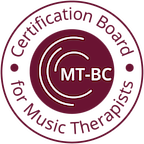An Overview of Auditory Perception Training in Music Therapy
 As many would agree, music has many physical, emotional, or psychological benefits. Music can evoke emotions, memories, thoughts, and behaviors that we may not have been able to access otherwise. This is why music therapy holds a valuable space in therapeutic professions and is growing in popularity as both a supportive and stand-alone therapy for treating various conditions such as Autism, developmental disabilities, depression, anxiety, trauma, chronic illness, memory deficits, and neurologic and physical impairments.
As many would agree, music has many physical, emotional, or psychological benefits. Music can evoke emotions, memories, thoughts, and behaviors that we may not have been able to access otherwise. This is why music therapy holds a valuable space in therapeutic professions and is growing in popularity as both a supportive and stand-alone therapy for treating various conditions such as Autism, developmental disabilities, depression, anxiety, trauma, chronic illness, memory deficits, and neurologic and physical impairments.
Today, we will highlight one specialized technique that Neurologic Music Therapists have the training to use in therapy: Auditory Perception Training. This technique involves training the brain to process and interpret sounds more effectively. The client can address and improve communication, social skills, and sensory perception by providing training on perception skills.
This blog post will provide an overview of the Auditory Perception Training technique. We will discuss how it works, its advantages, and how music therapy clients can benefit from it. This information is valuable for current clients who want to learn more about this technique and those interested in music therapy for themselves or a loved one. (If this is you, please download this free worksheet: Is Music Therapy Right For Your Loved One?)
What is Auditory Perception Training?
The basics of Auditory Perception Training in music therapy are based on the fact that music and sound can affect a person’s brain. But first, let’s break it down…
- Auditory perception refers to a person’s ability to recognize and interpret sound in the environment.
- Training refers to teaching a person or animal a skill or behavior.
- Music Therapy refers to using music as the primary tool for training non-musical skills and behaviors.
Therefore, Auditory Perception Training (APT) helps clients enhance their brain’s ability to hear, process, and interpret sounds in the environment more effectively. Music is used to expose the client to specific sounds and help them distinguish and differentiate between sounds in the environment. By doing so, clients can improve their language processing skills, understanding and response to their environment, and focus more on details in listening tasks.
Auditory Perception Training aims to improve an individual’s ability to process sounds and recognize auditory input, which in turn can improve their overall quality of life.
Who can benefit from Auditory Perception Training?
APT benefits people who have suffered hearing loss, have a processing disorder or have impairments on the auditory pathway. Music therapy puts specific emphasis on changing the sound of music and improving the audibility of certain sounds to enhance auditory perception.
This technique is often used with individuals who have experienced trauma, as they may struggle with sensory overload and have difficulty processing sounds in a safe and effective manner.
Who can benefit from Auditory Perception Training?
Auditory Perception Training can be beneficial for a wide range of individuals, including, but not limited to, those who:
- Deal with trauma responses,
- Live with Autism Spectrum Disorder,
- Have hearing loss.
- Have sensory processing issues,
- Deal with speech and language delays.
- Live with Neurological Conditions (such as stroke, traumatic brain injury, Parkinson’s disease, multiple sclerosis, and others)
As a result of all the above conditions, anxiety can be a shared symptom among all individuals struggling with auditory perception. APT can aid individuals who experience anxiety from over-attentiveness to their environment or under-awareness of their sensory surroundings. One of the essential benefits of APT is that it helps clients to relax and manage stress by gaining control over their processing of the external environment. With music as the primary tool and an effective calming agent, the therapist can train a client in an environment that provides non-verbal feedback and calm before generalizing into everyday life.
The benefits of Auditory Perception Training can vary and depend on the client’s needs, but they include improved language processing and increased accuracy in auditory perception and interpretation. With better communication skills and social self-expression, clients become more confident in everyday life and feel better about themselves with added control over their communication mindset.
Overall, auditory perception training through music therapy can positively impact many aspects of a person’s life, including communication, cognitive function, emotional well-being, and overall quality of life.
How does Auditory Perception Training work?
Auditory Perception Training helps improve a person’s ability to process sounds, including speech, music, environmental sounds, and other auditory stimuli. While working with a trained music therapist who has determined through an assessment that APT is an appropriate therapeutic intervention, the client works to distinguish different sounds, focus on specific auditory cues, and integrate auditory information with other sensory inputs. By improving the brain’s ability to process sounds, individuals can develop better communication skills and improve their ability to navigate the world around them. There are four key aspects of auditory perception that a therapist will taking into consideration with a client’s auditory perception training:
-
Auditory Differentiation
- What is it? One’s ability to understand and distinguish if an auditory input is the same or different based on sound intensity, pitch, volume, duration, etc.
- How does APT address auditory differentiation in music therapy? The elements of music (rhythm, melody, timbre, dynamics, etc.) are used to help clients with rhythm and melody perception skills. Inventions for rhythm perception will include differentiating fast and slow, various rhythms, and timing. Melody perception involves activities that help clients recognize and differentiate between melodies, pitches, and timbres. Because every client is different, the music therapist will tailor activities based on their needs to ensure their progress.
-
Auditory Memory and Attention
- What is it? One’s ability to store auditory information and recall it
- How does APT address auditory differentiation in music therapy? During an APT intervention, a client may be asked to listen closely to and remember a particular sound or sequence through listening skills alone. Doing these exercises consistently can help clients develop their memory skills, and they can use them in their daily life to remember names, directions, or instructions. APT helps clients filter out background noise and maintain attention, improving listening and comprehension skills.
-
Auditory Analysis and Synthesis
- What is it? One’s ability to break up sounds and also put them together in functional speech.
- How does APT address auditory differentiation in music therapy? A music therapist working on a client to separate sounds may ask the client to play three different instruments when isolating but combining sounds into a word. A simple example is C-A-T. The client would be instructed to engage in an intervention where he/she hits a drum for C, a tambourine for A, and a desk bell for T within the context of a song.
-
Auditory Figure Ground
- What is it? One’s ability to focus on a particular sound with the presence of another, non-important sound in the environment.
- How does APT address auditory differentiation in music therapy? A music t To address auditory figure-ground skills in music therapy, a clinician may have the client play a rhythm with a performed or recorded song (the client plays a song on the piano, Hokey Pokey, or Electric Slide on the iPad) and the therapist provides distractions in the room (slamming the door, playing off-key or tempo, etc.) and have the client practice remaining focused on the important auditory input.
Music therapy clients who undergo APT can benefit from improved listening skills, better ability to follow conversations, and increased awareness of environmental sounds. APT also helps clients differentiate between similar sounds, such as a ‘p’ sound and a ‘b’ sound. Music therapy typically uses songs with various sounds from different instruments and vocals to train the client’s brain to differentiate sounds more effectively. Music therapists will also use different kinds of noise to train clients to filter out irrelevant sounds so that they can focus on essential ones.
What are some examples of Auditory Perception Training activities?
Auditory Perception Training activities can vary based on the individual’s needs and goals. Some examples of activities that a music therapist may use include rhythm and timing exercises, pitch discrimination games, and auditory memory activities. These activities may be conducted in a one-on-one setting or a group therapy format. The key to successful Auditory Perception Training is consistency, as the brain needs a consistent routine to develop new neural pathways and effectively rewire itself.
A few intervention examples include:
- Freeze Game
- freeze when the music stops
- Memory and Attention
- Hot And Cold Drumming
- Hide an instrument, and when the drum gets louder, it cues the client they are getting closer to the hidden instrument, whereas when the drum grows quiet, they are moving further away.
- Stories
- The therapist facilitates songwriting with a client to create a personal story where different sounds/instruments/melodies represent different aspects of their story.
- The therapist sings a story, and the client must hit the drum whenever they hear a pre-determined word.
- Sequencing
- Using a pre-composed song to instruct the client to engage in 2- or 3-step directions (play drum, bell, sticks).
- Mood sequencing
- Using songwriting with the client to determine a sequence of events when an auditory stimulus is presented and triggers a trauma or negative response
- Example: house makes loud creaking noise at night…what is the sequential response following the auditory input? Maybe, take a breath, and hit play on a pre-recorded intervention that leads the client through guided calming techniques or a recording of the mother singing. This can be practiced in the therapy space and generalized into the evening.
- Using songwriting with the client to determine a sequence of events when an auditory stimulus is presented and triggers a trauma or negative response
- Sound Identification
- The therapist instructs the client to listen to the sounds “pah” and “bah” within the context of the song (
- Example: Therapist sings, “I Feel Better When I Sing Pah, Pah, Pah, Pah, Pah”. At the sound of “pah” or “bah,” the client determines if it is “P” or “B” and plays the drum labeled with the correct letter.
- The therapist instructs the client to listen to the sounds “pah” and “bah” within the context of the song (
Music Therapy is a powerful tool for individuals struggling with various health conditions. Through techniques such as Auditory Perception Training, music therapists can help individuals improve their brain’s ability to process and interpret sounds. By doing so, individuals may improve their overall quality of life, including improved communication skills, emotional regulation, and increased confidence. If you or a loved one are interested in exploring music therapy, contact me here, and we can dive into how music therapy can help you or your loved one reach life-changing goals!
If you have questions or want more information about music therapy, please contact me!
Sincerely,
Jessica Ditty, MM, MT-BC, NMT



